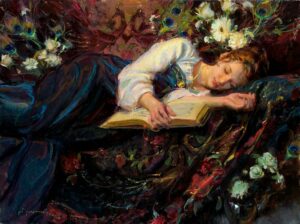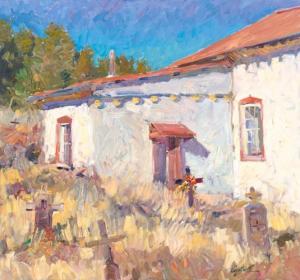A question that invariably is asked by students or observers during a workshop or demo is “How do I develop a style?” A comment I often hear from fellow artists at shows, galleries and museums is “I would recognize his/her style anywhere.” As artists, we want our work to stand out for its individuality, to be recognized as part of our body of work and for what we have to say as an artist even though our style may evolve throughout our career.
Brush mileage is the answer we hear for how to become proficient as a painter. I believe this applies to developing a style as well. Style develops while learning to master the elements that are essential in a great painting. When an artist takes on the prolonged study of painting, the essentials become a natural part of the artist. Hopefully, we will continue to learn and grow as an artist, to experiment and improve. As a result our style becomes a work in progress.
The elements listed below have been discussed and dissected in countless books and articles. They are intertwined in a painting and cannot be completely separated other than as a basis for study and learning.

Color Palette – As artists, we choose to limit the number of colors we lay on our palette. We choose which warms, which cools, which darks and lights, transparent and opaque, so on and so forth. We will during the course of our career even zero in on brand choice. So, our palette and choice of colors becomes part of our recognizable style.

Composition and Focal Point – An artist moves you around and through a painting with the use of darks and lights, pure rich colors and grays as well as where they place the focal point. Edges, texture and brush strokes are crucial in aiding this movement around the painting and to the center of interest.
Edges – The use of edges, soft, hard and intermediate serve to strengthen the composition. Sometimes I think that the pursuit of edges may be the most difficult to master.
Texture – This applies not only to thick/and or thin application of paint, but it also applies to the surface we choose to work on for each painting: from gessoed boards to stretched or mounted linens and canvas, fine weave to coarse weave, etc. I have seen beautiful works painted on copper and on aluminum salvaged from soft drink cans. The surface we choose becomes very much a part of our style.
Brush strokes and paint application – Choice of brush, i.e. bristle, sable, nylon, filbert, flat, bright, etc. or palette knife, whether applied thick, thin, broken, and the length of stroke becomes inherent to the artist. This inherent quality helps to mark his style, it is his signature so to speak.
Subject matter – I have often heard it said that there is no new subject matter, just new ways to present it. That uniqueness of presentation is style. It is what differentiates us as artists and as human beings.
In his book, Alla Prima, Richard Schmid tells us: “Do not ask yourself, “What do I see?” Rather ask, “What do I see?” In doing so, we are on our way to developing our own style.
Double Chromosome Arteest says
Finally, an article written by a woman artist, and then she uses examples of work by…MEN. The art world is so top heavy with male artists, that even women forget that we’re at a distinct disadvantage for exposure of our work.
Susan Vaughn says
I completely agree that Artists develop a “style” over time. I find that on Facebook, as I scroll thru my Newsfeed, I see paintings, and can almost surely identity the Artist even before I check to see who painted it! I do, though, occasionally wonder what style I have developed in my own body of work. And, since it is difficult for an Artist to “see” his own style, I can only hope my style is a good one!!
Tina Garrett says
Very well said Fran. Having a style per say, has been a concern for me. You’ve given me a sense of peace. Now I believe it will come as I continue to learn and grow. Beautifully written and simply said. Thank you.
Fred Hope says
While I certainly agree with everything said above, I would add that a study of Art History is as important as technical skills and brush mileage in the development of one’s unique style. Without an awareness of all that has come before, there is a great risk of “reinventing the wheel” as we look for ways to express our own vision through our work.
Additionally, the importance of drawing cannot be overstated. As one studies the all time great artists of any era, genre and style, the most consistent link between them has been drawing. It is the fastest way I know to search for, and begin to find one’s own “self” in one’s work. That is where the foundation of a “style” is built.
MDowns says
Enjoyed your article. I do have one question. Why we as artists would choose to limit our color choices ? Why not a full palette of color choices say min of 9 colors to 16 to 25 color palette?
Thanks
M
Kathryn Trillas says
I remember teaching a freshman drawing class, where I was limited to line drawing, as in no shading, etc. The students were a mix of BFA and Liberal Arts students. Style was an early topic of the students. I asked them to give me their focus to learn the skills of drawing, perspective, negative and positive space, as well as the tools, charcoal and graphite, and I boldly guaranteed them their personal style would become apparent. I had no resources for props, so day in and day out these kids were drawing paper bags. As a still life or individual bags. Well blow me down! By the end of the semester, when we hung the work up as our final show, we could all see a clear difference in each piece of work. I could even name which drawing belonged to a particular student. I had put forth the theory, a little earlier in the year, that individual style comes from the heart, the head, and the gut and is demonstrated in the skill of drawing, in this case. Each student, or person, brings their own “baggage,” so to speak, to the work. We are who we are, and that who is inevitably reflected in the work we do.
I have been in shows where a “comments” book were the norm, some of those comments came so close to my personal feelings and thoughts, it was down right scary. Our choices, development of our skills, preference of color, light, and even subject is a way we express style. Our individual life story is also very much a part of that style.
Kim Carlton says
Nice article, Fran. I think the paintings you chose really illustrate your point perfectly; well done!
Judy A. Crowe says
Good article Fran!